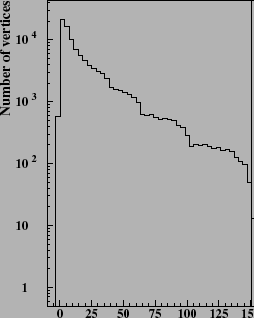Next: Luminosity Determination Up: Inclusive Production Cross Sections Previous: Detector Resolution Contents
In order to produce a cross section measurement effects of the detector acceptance have to be corrected. For the proper acceptance determination, parameters like detector efficiencies and resolution are very important, because they can influence the track reconstruction efficiency. For the simulation of the Innner Tracker performance, the efficiencies obtained in the ITR performance studies and described in the Section 5 are used.
For the study of the acceptance of HERA-B 1,000,000 inelastic events for each target wire, used during data taking in 2002, were generated with the HERA-B Monte-Carlo chain, including the full detector simulation.
The overall acceptance can be subdivided into the
geometrical acceptance and the reconstruction efficiency.
A ![]() is considered
to be in the geometrical acceptance of the detector if its decay products
pass through enough layers of tracking stations in the PC area. In additional,
the decay's vertex has to be measured, which means the tracks have to be measured by the Vertex Detector System.
These requirements are checked with the Monte Carlo Impact Points (MIMPs) and the
decay position (
is considered
to be in the geometrical acceptance of the detector if its decay products
pass through enough layers of tracking stations in the PC area. In additional,
the decay's vertex has to be measured, which means the tracks have to be measured by the Vertex Detector System.
These requirements are checked with the Monte Carlo Impact Points (MIMPs) and the
decay position (![]() coordinate) of the
coordinate) of the ![]() candidate.
A requirement on the number of crossed layers in the PC area is needed,
because a track with less than 5 MIMPs can not be reconstructed by the
pattern recognition program.
The cut at the
candidate.
A requirement on the number of crossed layers in the PC area is needed,
because a track with less than 5 MIMPs can not be reconstructed by the
pattern recognition program.
The cut at the ![]() position of the secondary vertex is based on the plot
shown in Fig. 6.6
position of the secondary vertex is based on the plot
shown in Fig. 6.6
 |
The geometrical description used for this acceptance study is valid for the detector configuration used during data taking in 2002/2003 (both Inner Tracker and Outer Tracker were fully installed and equipped). The resulting geometrical acceptance functions are shown in Fig. 6.7.
For the cross-section calculation a full acceptance (geometrical acceptance plus
reconstruction efficiencies) function is needed.
In order to obtain the full acceptance function, the generated MC sample was
reconstructed and distributions of the kinematical variables (![]() ,
, ![]() ) are
produced. Such variables are chosen because they are of special interest for the
fragmentation processes.
The kinematical variables are plotted for reconstructed MC and the original MC truth.
The ratios of these distributions:
) are
produced. Such variables are chosen because they are of special interest for the
fragmentation processes.
The kinematical variables are plotted for reconstructed MC and the original MC truth.
The ratios of these distributions:
 |
(6.5) |
The HERA-B spectrometer covers the central production region in the overall
proton-nucleon center of mass system. This can be seen from the acceptance plots
as a function of ![]() . The range -0.03
. The range -0.03 ![]() 0.01 is covered with an acceptance
larger than 0.1 and with lower acceptance it extends up to -0.12 and 0.04 for
0.01 is covered with an acceptance
larger than 0.1 and with lower acceptance it extends up to -0.12 and 0.04 for ![]() .
Acceptances of
.
Acceptances of ![]() s and
s and
![]() s are approximately covering the same region
with lower values
s are approximately covering the same region
with lower values ![]() 6% and the center of gravity of the distributions are
shifted more to the negative region compared to the acceptance of the
6% and the center of gravity of the distributions are
shifted more to the negative region compared to the acceptance of the ![]() .
.
Yury Gorbunov 2010-10-21